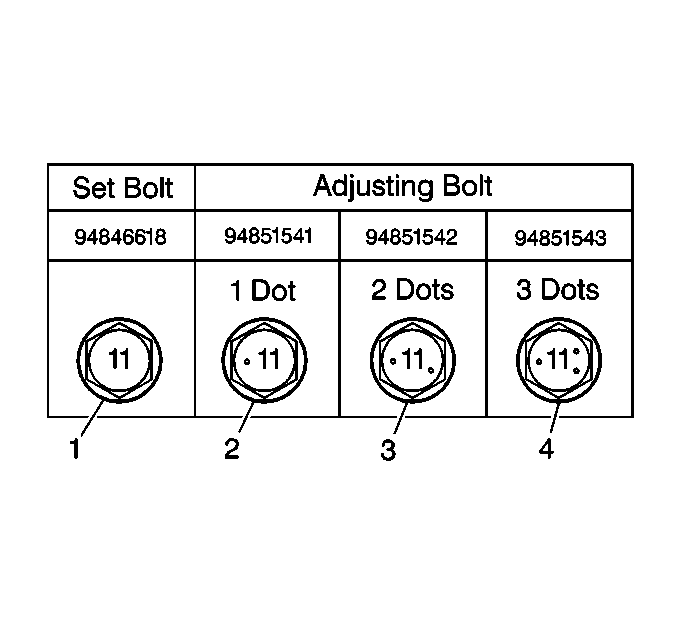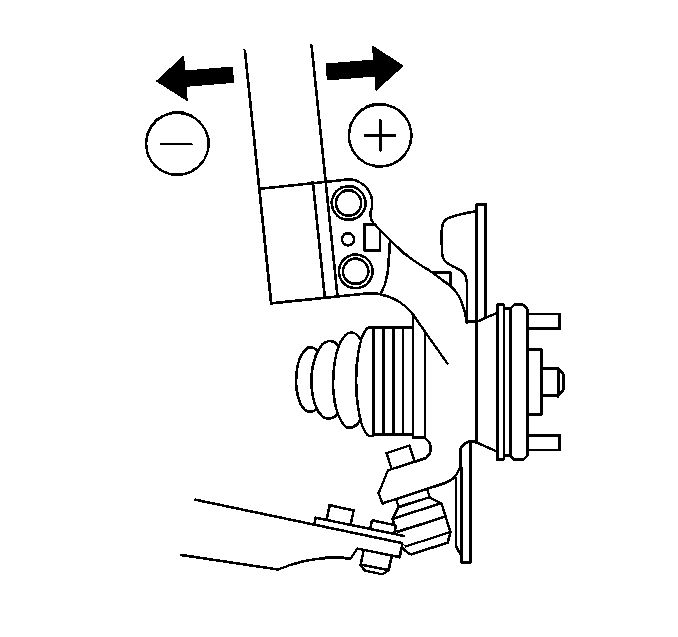The alignment equipment varies in design and capabilities.
Consult with the equipment manufacturer's guidelines prior to setting this
angle.

- If the front camber is
not within the service allowable range, estimate how much you need to move
the front camber. Select the appropriate combination of bolts in order to
move the front camber to be within the service allowable range. Refer to
Wheel Alignment Specifications
.
| • | In order to move the camber +/- 0.25 degree, use
bolt (1), GM P/N 94846618, in the upper bolt position,
and bolt (2), GM P/N 94851541, in the lower bolt position. |
| • | In order to move the camber +/- 0.50 degree, use
bolt (1), GM P/N 94846618, in the upper bolt position,
and bolt (3), GM P/N 94851542, in the lower bolt position. |
| • | In order to move the camber +/- 0.75 degree, use
bolt (1), GM P/N 94846618, in the upper bolt position,
and bolt (4), GM P/N 94851543, in the lower bolt position. |
| • | In order to move the camber +/- 1.00 degree, use
bolt (2), GM P/N 94851541, in the upper bolt position,
and bolt (4), GM P/N 94851543, in the lower bolt position. |
| • | In order to move the camber +/- 1.25 degree, use
bolt (3), GM P/N 94851542, in the upper bolt position,
and bolt (4), GM P/N 94851543, in the lower bolt position. |
| • | In order to move the camber +/- 1.50 degree, use
bolt (4), GM P/N 94851543, in the upper bolt position,
and bolt (4), GM P/N 94851543, in the lower bolt position. |

- Raise and support the
front of the vehicle with the alignment equipment. Refer to
Lifting and Jacking the Vehicle
in General Information.
- Remove the front tire and wheel assembly from the vehicle. Refer
to
Tire and Wheel Removal and Installation
in Tires and Wheels.
- Remove the 2 nuts (1, 2) on the lower side
of the strut.
- Remove the bolt from the upper bolt position (1).
- Install the selected bolt for the upper bolt position.
- Remove the bolt from the lower bolt position (2).
- Install the selected bolt for the lower bolt position.
- Coat the nut's threads with engine oil.
- Temporarily install the 2 nuts. DO NOT tighten the nuts.
- Install the front tire and wheel assembly. Refer to
Tire and Wheel Removal and Installation
in Tires
and Wheels.
Important: The weight of the vehicle must be on the tires.
- Lower the vehicle onto the alignment equipment.
- Measure the alignment.

- Push or pull on the top
of the tire and wheel assembly in order to move the camber to be within the
service allowable range. Refer to
Wheel Alignment Specifications
.
Notice: Use the correct fastener in the correct location. Replacement fasteners
must be the correct part number for that application. Fasteners requiring
replacement or fasteners requiring the use of thread locking compound or sealant
are identified in the service procedure. Do not use paints, lubricants, or
corrosion inhibitors on fasteners or fastener joint surfaces unless specified.
These coatings affect fastener torque and joint clamping force and may damage
the fastener. Use the correct tightening sequence and specifications when
installing fasteners in order to avoid damage to parts and systems.
- Tighten the nuts
and the bolts on the lower side of the strut.
Tighten
Tighten the nuts and the bolts to 274 N·m (203 lb ft).



